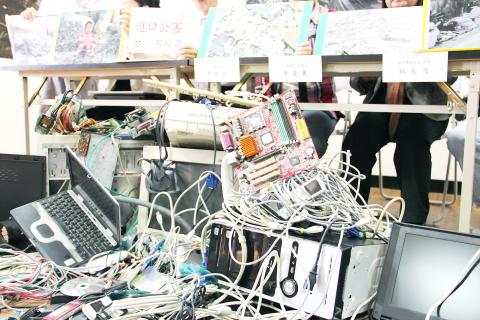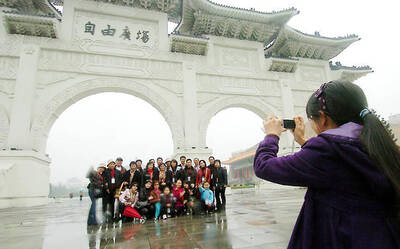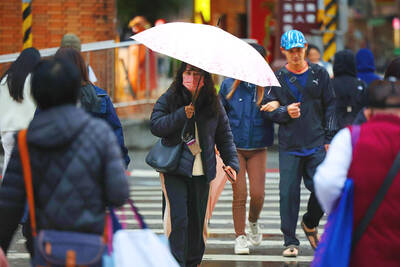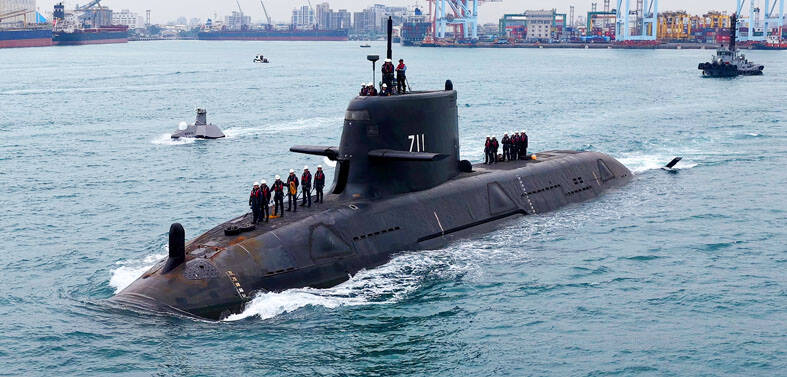Environmental activists yesterday urged the government not to exclude scrap metal, including electrical and electronics equipment, from its definition of hazardous industrial waste, as this would allow its import into Taiwan.
The Environmental Protection Administration (EPA) is considering amending the Standards for Defining Hazardous Industrial Waste (有害事業廢棄物認定標準) to exclude 12 types of scrap metal — including wires, computers, household electronics, telecom products and printed circuit boards — and redefine them as general industrial waste, which are not banned from import into the nation, environmental advocates said.
Showing photographs taken years ago of waste circuit boards and wires piled up along the banks of the Erjen River (二仁溪), with hundreds of fish lying dead on sections of the river bank, the groups said they fear that once the standards are amended, the public would see a repetition of those horrific scenes of rivers polluted by toxic chemicals across the nation.

Photo: CNA
Homemakers United Foundation president Chen Man-li (陳曼麗) said 1,800 tonnes of domestic industrial waste are created each year, and while the EPA claims a high recycling rate of 82 percent, many toxic substances, such as furnace slag ashes, remain and pollute the environment.
“Don’t we have enough domestic industrial waste to worry about?” Chen asked.
“The public is now worried about the safety of adulterated edible oil products, but the pollution from recycling these scrap metals may affect an even bigger portion of our living environment,” she said.
Tainan Community University Research and Development Association director Huang Huan-chang (黃煥彰) said since the early 1970s, the scrap metal recycling industry by the Erjen River has already caused irreversible heavy pollution to the air, water and soil, from the burning of plastic parts and pickling metal with strong liquid acid to extract precious metals.
He said that the high level of dioxins in the air and heavy metal contamination in the water and soil near the Erjen River led a Canadian researcher to define the area as “unsuitable for living” in 1983. The pollution was finally halted by the government, which spent up to NT$4.2 billion (US$142.5 million) for river remediation over the past two to three decades.
Taiwan Watch Institute director Herlin Hsieh (謝和霖) said many of the waste electronic products contain brominated flame retardant, which may release highly toxic polybrominated dibenzo-p-dioxins and dibenzofurans when burned and are endocrine disrupting chemicals that may affect the brain.
“The main objective of the Basel Convention on the Control of Transboundary Movements of Hazardous Wastes and their Disposal is to restrict transboundary movements of hazardous wastes,” Huang said.
“Taiwan is a small island that cannot afford to become a hazardous waste treatment center for other countries,” Huang said.
In response, EPA Department of Waste Management director Wu Tien-chi (吳天基) said that while the nation lacks resources, it is an electronics export-oriented economy.
To vertically integrate the industry from manufacturing to consumption to recycling, the EPA is considering allowing the import of scrap metal to aid the development of the recycling industry.
Recycling companies will be required to report their treatment process, and the remaining waste substances will be disposed of using legal facilities, he added.

US climber Alex Honnold is to attempt to scale Taipei 101 without a rope and harness in a live Netflix special on Jan. 24, the streaming platform announced on Wednesday. Accounting for the time difference, the two-hour broadcast of Honnold’s climb, called Skyscraper Live, is to air on Jan. 23 in the US, Netflix said in a statement. Honnold, 40, was the first person ever to free solo climb the 900m El Capitan rock formation in Yosemite National Park — a feat that was recorded and later made into the 2018 documentary film Free Solo. Netflix previewed Skyscraper Live in October, after videos

NUMBERS IMBALANCE: More than 4 million Taiwanese have visited China this year, while only about half a million Chinese have visited here Beijing has yet to respond to Taiwan’s requests for negotiation over matters related to the recovery of cross-strait tourism, the Tourism Administration said yesterday. Taiwan’s tourism authority issued the statement after Chinese-language daily the China Times reported yesterday that the government’s policy of banning group tours to China does not stop Taiwanese from visiting the country. As of October, more than 4.2 million had traveled to China this year, exceeding last year. Beijing estimated the number of Taiwanese tourists in China could reach 4.5 million this year. By contrast, only 500,000 Chinese tourists are expected in Taiwan, the report said. The report

Temperatures are forecast to drop steadily as a continental cold air mass moves across Taiwan, with some areas also likely to see heavy rainfall, the Central Weather Administration (CWA) said. From today through early tomorrow, a cold air mass would keep temperatures low across central and northern Taiwan, and the eastern half of Taiwan proper, with isolated brief showers forecast along Keelung’s north coast, Taipei and New Taipei City’s mountainous areas and eastern Taiwan, it said. Lows of 11°C to 15°C are forecast in central and northern Taiwan, Yilan County, and the outlying Kinmen and Lienchiang (Matsu) counties, and 14°C to 17°C

STEERING FAILURE: The first boat of its class is experiencing teething issues as it readies for acceptance by the navy, according to a recent story about rudder failure The Hai Kun (海鯤), the nation’s first locally built submarine, allegedly suffered a total failure of stern hydraulic systems during the second round of sea acceptance trials on June 26, and sailors were forced to manually operate the X-rudder to turn the submarine and return to port, news Web site Mirror Daily reported yesterday. The report said that tugboats following the Hai Kun assisted the submarine in avoiding collisions with other ships due to the X-rudder malfunctioning. At the time of the report, the submarine had completed its trials and was scheduled to begin diving and surfacing tests in shallow areas. The X-rudder,